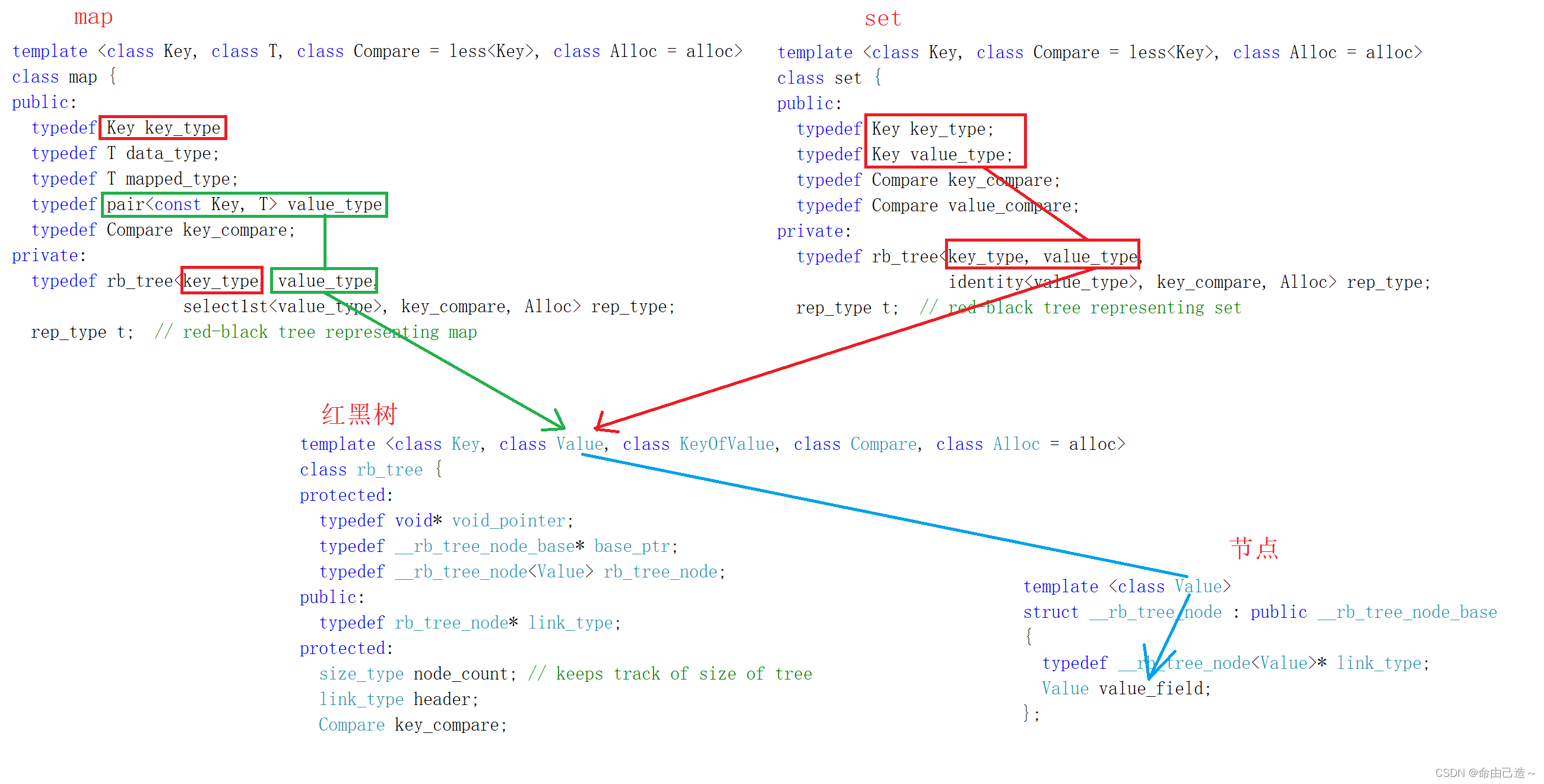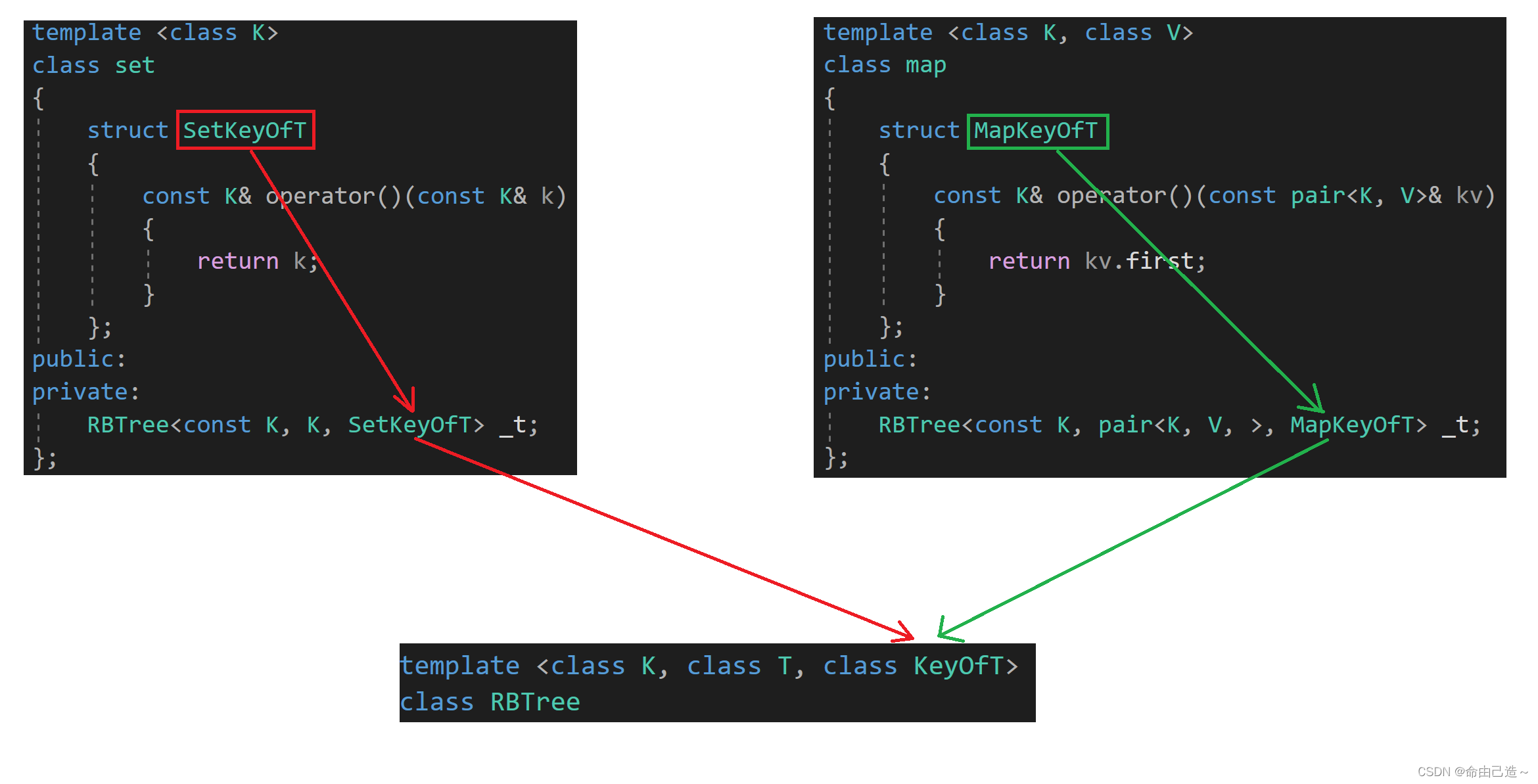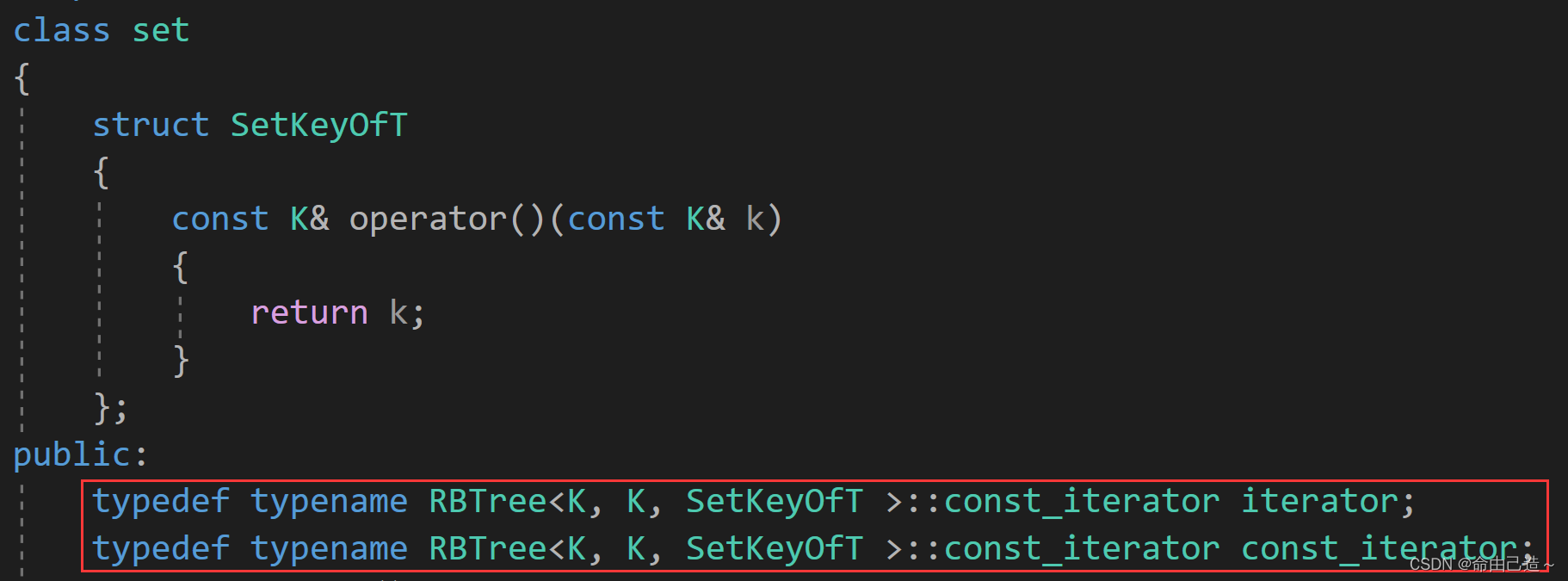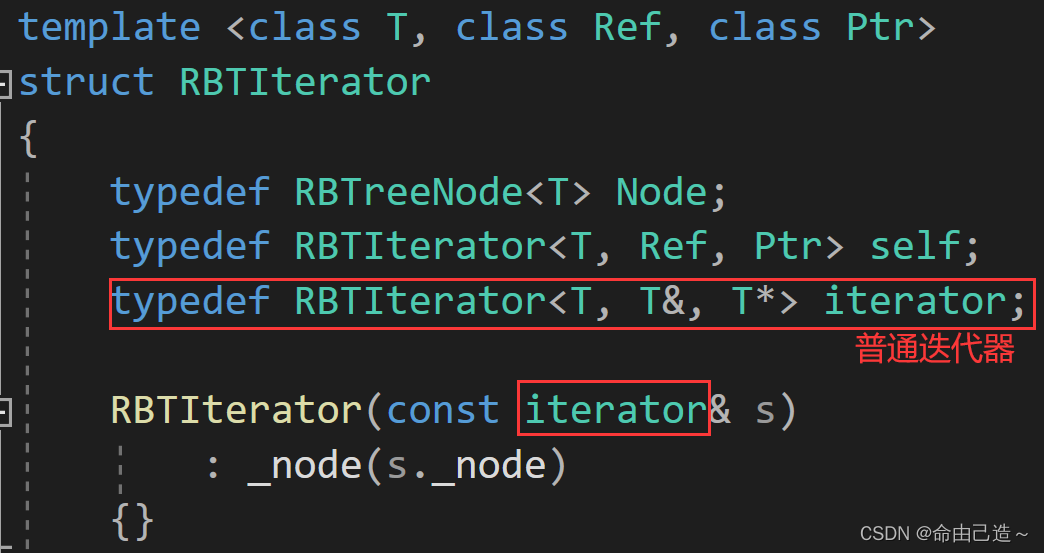一、介绍
首先要知道map和set的底层都是用红黑树实现的
【数据结构】红黑树
set只需要一个key,但是map既有key也有val。
那么我们怎么同时兼容呢?
二、stl源码剖析

从这张图可以看出红黑树的节点里面存的类型是由Value决定的,跟Key无关。
所以我们实现的时候就可以给RBTree添加一个模板参数
template<class K, class T>
class RBTree
T模板参数我们既可以传K也可以传pair<k, V>
set:
template <class K>
class set
{
private:
RBTree<K,K> _t;
};
map:
template <class K, class V>
class map
{
private:
RBTree<K, pair<const K,V>> _t;
};
既然通过第二个参数就能确定节点的类型,那么第一个参数有什么用呢?
当我们查找的时候,如果是map,第二个参数就是pair类型,不能使用,所以得加上第一个参数,方便查找。
参照stl的方法定义节点:
template <class T>
struct RBTreeNode
{
RBTreeNode(const T& data)
: _data(kv)
, _left(nullptr)
, _right(nullptr)
, _parent(nullptr)
, _col(RED)
{
}
T _data;
RBTreeNode<K, V>* _left;
RBTreeNode<K, V>* _right;
RBTreeNode<K, V>* _parent;
Colour _col;
};
三、仿函数获取数值
我们知道红黑树是搜索树,插入的时候需要比较大小,而我们插入的有可能是K,也有可能是pair<K, V>,导致我们无法直接比较。
而stl的做法就是利用仿函数获取我们需要进行比较的元素。

set:
template <class K>
class set
{
struct SetKeyOfT
{
const K& operator()(const K& k)
{
return k;
}
};
public:
private:
RBTree<K, K, SetKeyOfT> _t;
};
map:
template <class K, class V>
class map
{
struct MapKeyOfT
{
const K& operator()(const pair<K, V>& kv)
{
return kv.first;
}
};
public:
private:
RBTree<K, pair<K, V, >, MapKeyOfT> _t;
};

进行大小比较
KeyOfT kot;// 仿函数比较
Node* parent = nullptr;
Node* cur = _root;
while (cur)
{
if (kot(cur->_data) < kot(data))
{
parent = cur;
cur = cur->_left;
}
else if (kot(cur->_data) > kot(data))
{
parent = cur;
cur = cur->_right;
}
else return false;
}
四、红黑树的迭代器
template <class T, class Ref, class Ptr>
struct RBTIterator
{
typedef RBTreeNode<T> Node;
typedef RBTIterator<T, Ref, Ptr> self;
RBTIterator(Node* node)
: _node(node)
{
}
Node* _node;
};
*:解引用操作,返回对应结点数据的引用:
Ref operator*()
{
return _node->_data;
}
->:访问成员操作符,返回节点数据的地址
Ptr operator->()
{
return &_node->_data;
}
!=、== 比较迭代器是否指向同一节点
bool operator!=(const self& it)
{
return _node != it._node;
}
bool operator==(const self& it)
{
return _node == it._node;
}
begin() 和 end()
begin():返回的是最左节点(中序遍历的第一个节点)
end():迭代器的end()一般是返回最后一个节点的下一个位置,这里设置为nullptr。
typedef RBTIterator<T, T&, T*> iterator;
typedef RBTIterator<T, const T&, const T*> const_iterator;
iterator begin()
{
Node* cur = _root;
while (cur && cur->_left)
{
cur = cur->_left;
}
return iterator(cur);
}
iterator end()
{
return iterator(nullptr);
}
map里面的begin()与end()
typedef typename RBTree<K, pair<const K, V>, MapKeyOfT >::iterator iterator;
iterator begin()
{
return _t.begin();
}
iterator end()
{
return _t.end();
}
这里注意因为编译的时候编译器不知道RBTree<K, pair<const K, V>, MapKeyOfT >::iterator这是个类型还是静态成员变量,会编译出错,加上typename就是告诉编译器这里是一个类型。
set的begin()和end()
typedef typename RBTree<K, K, SetKeyOfT >::iterator iterator;
iterator begin()
{
return _t.begin();
}
iterator end()
{
return _t.end();
}
这里重要的是迭代器的++和--
++:
寻找中序遍历的下一个节点:
1️⃣ 如果右子树不为空,++就是找右子树的最左节点。
1️⃣ 如果右子树为空,++就是找祖先(孩子是父亲的左的那个祖先)
self& operator++()
{
if (_node->_right)
{
Node* min = _node->_right;
while (min->_left)
{
min = min->_left;
}
_node = min;
}
else
{
Node* cur = _node;
Node* parent = cur->_parent;
while (parent && parent->_right == cur)
{
cur = parent;
parent = parent->_parent;
}
_node = parent;
}
return *this;
}
--:
跟++刚好是反过来:
1️⃣ 如果左子树不为空,++就是找左子树的最右节点。
1️⃣ 如果左子树为空,++就是找祖先(孩子是父亲的右的那个祖先)
self& operator--()
{
if (_node->_left)
{
Node* max = _node->_left;
while (max && max->_right)
{
max = max->_right;
}
_node = max;
}
else
{
Node* cur = _node;
Node* parent = cur->_parent;
while (parent && parent->_left == cur)
{
cur = parent;
parent = parent->_parent;
}
_node = parent;
}
return *this;
}
这里还有一个重要的问题:
如果这么写那么set的值也可以被修改。那么如何保证set不能被修改呢?

可以直接把普通迭代器和const迭代器都变成const_iterator。
此时这里会出现问题:
iterator begin()
{
return _t.begin();
}
iterator end()
{
return _t.end();
}
这里_t是普通对象,会调用普通的迭代器,类型不同,无法返回。

我们只需要在函数后面加上const就可以权限缩小,变成const对象。
iterator begin() const
{
return _t.begin();
}
iterator end() const
{
return _t.end();
}
在红黑树中也要加入对应的const版本begin()和end()
const_iterator begin() const
{
Node* cur = _root;
while (cur && cur->_left)
{
cur = cur->_left;
}
return const_iterator(cur);
}
const_iterator end() const
{
return const_iterator(nullptr);
}
五、map的[]
当我们想使用map来统计次数的时候,就需要重载[]。
如果想要支持[],那么insert的返回值就得设置成pair<iterator, bool>。
如果在bool就是false,iterator返回当前节点。
return make_pair(iterator(cur), false);
不在就插入。
return make_pair(iterator(newnode), true);
map:
V& operator[](const K& key)
{
pair<iterator, bool> ret = insert(make_pair(key, V()));
return ret.first->second;
}
这里要注意set:
pair<iterator, bool> insert(const K& k)
{
return _t.insert(k);
}
这里的iterator其实是const_iterator,所以导致类型不同。
5.1 普通迭代器转const迭代器
正常情况下普通迭代器不能转化为const迭代器。
为了解决这种情况,我们在迭代器内添加一个拷贝构造即可。

1️⃣ 当传进来的是普通迭代器的时候,iterator是普通迭代器,这个函数相当于拷贝构造
2️⃣ 当传进来的是const迭代器的时候,iterator依然是普通迭代器,此时该函数就相当于构造函数(普通迭代构造const迭代器)。
其实普通迭代器和const的区别就在operator*和operator->
而set的插入不需要修改:
pair<iterator, bool> insert(const K& k)
{
return _t.insert(k);
}
return的时候会调用拷贝构造函数,也就是构造函数,把普通迭代器转化为const迭代器。
六、set源码
#pragma once
#include "RBTree.h"
namespace yyh
{
template <class K>
class set
{
struct SetKeyOfT
{
const K& operator()(const K& k)
{
return k;
}
};
public:
typedef typename RBTree<K, K, SetKeyOfT >::const_iterator iterator;
typedef typename RBTree<K, K, SetKeyOfT >::const_iterator const_iterator;
iterator begin() const
{
return _t.begin();
}
iterator end() const
{
return _t.end();
}
pair<iterator, bool> insert(const K& k)
{
return _t.insert(k);
}
private:
RBTree<K, K, SetKeyOfT> _t;
};
}
七、map源码
#pragma once
#include "RBTree.h"
namespace yyh
{
template <class K, class V>
class map
{
struct MapKeyOfT
{
const K& operator()(const pair<K, V>& kv)
{
return kv.first;
}
};
public:
typedef typename RBTree<K, pair<const K, V>, MapKeyOfT >::iterator iterator;
typedef typename RBTree<K, pair<const K, V>, MapKeyOfT >::const_iterator \
const_iterator;
iterator begin()
{
return _t.begin();
}
iterator end()
{
return _t.end();
}
const_iterator begin() const
{
return _t.begin();
}
const_iterator end() const
{
return _t.end();
}
pair<iterator, bool> insert(const const pair<K, V>& kv)
{
return _t.insert(kv);
}
V& operator[](const K& key)
{
pair<iterator, bool> ret = insert(make_pair(key, V()));
return ret.first->second;
}
private:
RBTree<K, pair<const K, V>, MapKeyOfT> _t;
};
}
八、红黑树源码
#pragma once
#include <iostream>
#include <cstdlib>
#include <cassert>
#include <string>
using namespace std;
enum Colour
{
RED,
BLACK,
};
template <class T>
struct RBTreeNode
{
RBTreeNode(const T& data)
: _data(data)
, _left(nullptr)
, _right(nullptr)
, _parent(nullptr)
, _col(RED)
{
}
T _data;
RBTreeNode<T>* _left;
RBTreeNode<T>* _right;
RBTreeNode<T>* _parent;
Colour _col;
};
template <class T, class Ref, class Ptr>
struct RBTIterator
{
typedef RBTreeNode<T> Node;
typedef RBTIterator<T, Ref, Ptr> self;
typedef RBTIterator<T, T&, T*> iterator;
RBTIterator(const iterator& s)
: _node(s._node)
{
}
RBTIterator(Node* node)
: _node(node)
{
}
Ref operator*()
{
return _node->_data;
}
Ptr operator->()
{
return &_node->_data;
}
bool operator!=(const self& it)
{
return _node != it._node;
}
bool operator==(const self& it)
{
return _node == it._node;
}
self& operator++()
{
if (_node->_right)
{
Node* min = _node->_right;
while (min->_left)
{
min = min->_left;
}
_node = min;
}
else
{
Node* cur = _node;
Node* parent = cur->_parent;
while (parent && parent->_right == cur)
{
cur = parent;
parent = parent->_parent;
}
_node = parent;
}
return *this;
}
self& operator--()
{
if (_node->_left)
{
Node* max = _node->_left;
while (max && max->_right)
{
max = max->_right;
}
_node = max;
}
else
{
Node* cur = _node;
Node* parent = cur->_parent;
while (parent && parent->_left == cur)
{
cur = parent;
parent = parent->_parent;
}
_node = parent;
}
return *this;
}
Node* _node;
};
template <class K, class T, class KeyOfT>
class RBTree
{
public:
typedef RBTreeNode<T> Node;
typedef RBTIterator<T, T&, T*> iterator;
typedef RBTIterator<T, const T&, const T*> const_iterator;
iterator begin()
{
Node* cur = _root;
while (cur && cur->_left)
{
cur = cur->_left;
}
return iterator(cur);
}
iterator end()
{
return iterator(nullptr);
}
const_iterator begin() const
{
Node* cur = _root;
while (cur && cur->_left)
{
cur = cur->_left;
}
return const_iterator(cur);
}
const_iterator end() const
{
return const_iterator(nullptr);
}
pair<iterator, bool> insert(const T& data)
{
if (_root == nullptr)
{
_root = new Node(data);
_root->_col = BLACK;
return make_pair(iterator(_root), true);
}
KeyOfT kot;// 仿函数比较
Node* parent = nullptr;
Node* cur = _root;
while (cur)
{
if (kot(cur->_data) > kot(data))
{
parent = cur;
cur = cur->_left;
}
else if (kot(cur->_data) < kot(data))
{
parent = cur;
cur = cur->_right;
}
else return make_pair(iterator(cur), false);
}
cur = new Node(data);
Node* newnode = cur;
if (kot(data) < kot(parent->_data))
{
parent->_left = cur;
}
else
{
parent->_right = cur;
}
cur->_parent = parent;
while (parent && parent->_col == RED)
{
// 找g 与 u
Node* g = parent->_parent;
if (parent == g->_left)
{
Node* u = g->_right;
// 情况一 u存在且为红
if (u && u->_col == RED)
{
parent->_col = u->_col = BLACK;
g->_col = RED;
// 继续往上处理
cur = g;
parent = cur->_parent;
}
else // 情况二或情况三
{
if (cur == parent->_left)// 情况二
{
// g
// p
// c
RotateR(g);
parent->_col = BLACK;
g->_col = RED;
}
else// 情况三
{
// g
// p
// c
RotateL(parent);
RotateR(g);
// c
// p g
cur->_col = BLACK;
g->_col = RED;
}
break;
}
}
else
{
Node* u = g->_left;
// 情况一
if (u && u->_col == RED)
{
u->_col = parent->_col = BLACK;
g->_col = RED;
cur = g;
parent = cur->_parent;
}
else
{
// 情况二
// g
// p
// c
if (cur == parent->_right)
{
RotateL(g);
parent->_col = BLACK;
g->_col = RED;
}
else// 情况三
{
// g
// p
// c
RotateR(parent);
RotateL(g);
cur->_col = BLACK;
g->_col = RED;
}
break;
}
}
}
// 上面有可能把_root的颜色变为红
_root->_col = BLACK;
return make_pair(iterator(newnode), true);
}
void RotateL(Node* parent)
{
Node* top = parent->_parent;
Node* right = parent->_right;
parent->_right = right->_left;
if (right->_left) right->_left->_parent = parent;
right->_left = parent;
parent->_parent = right;
if (top)// 子树
{
if (parent == top->_left) top->_left = right;
else top->_right = right;
right->_parent = top;
}
else// 完整的树
{
_root = right;
_root->_parent = nullptr;
}
}
void RotateR(Node* parent)
{
Node* top = parent->_parent;
Node* left = parent->_left;
Node* leftR = left->_right;
parent->_left = leftR;
if (leftR) leftR->_parent = parent;
left->_right = parent;
parent->_parent = left;
if (top)
{
if (parent == top->_left) top->_left = left;
else top->_right = left;
left->_parent = top;
}
else
{
_root = left;
_root->_parent = nullptr;
}
}
void _Inorder(Node* root)
{
if (root == nullptr)
return;
_Inorder(root->_left);
cout << root->_kv.first << "<=>" << root->_kv.second << endl;
_Inorder(root->_right);
}
void Inorder()
{
_Inorder(_root);
}
bool _IsBalance(Node* root, int i, int flag)
{
if (root == nullptr)
{
if (i != flag)
{
cout << "errno: 左右子树黑色节点数目不同" << endl;
return false;
}
return true;
}
// 红节点时判断父亲
if (root->_col == RED)
{
if (root->_parent->_col == RED)
{
cout << "errno: 红-红" << endl;
return false;
}
}
if (root->_col == BLACK)
{
i++;
}
return _IsBalance(root->_left, i, flag)
&& _IsBalance(root->_right, i, flag);
}
bool IsBalance()
{
if (_root == nullptr)
{
return true;
}
if (_root->_col != BLACK)
{
return false;
}
// 找标准值
Node* cur = _root;
int flag = 0;
while (cur)
{
if (cur->_col == BLACK)
{
flag++;
}
cur = cur->_left;
}
int i = 0;
return _IsBalance(_root, i, flag);
}
private:
Node* _root = nullptr;
};